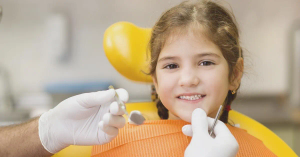Oral cancer, though more commonly seen in adults, can also occur in children. While its prevalence in the pediatric population is relatively low, early diagnosis is crucial for better treatment outcomes. Diagnostic aids are tools or technologies used to detect diseases or abnormalities in their early stages. In the case of oral cancer, advanced diagnostic aids help healthcare providers identify potential malignancies before they progress, significantly improving the prognosis.
Prevalence of Oral Cancer in Children
Oral cancer in children is relatively rare compared to adults, but it still poses significant health risks. Oral squamous cell carcinoma (OSCC) is the most common type of oral cancer in children, though its incidence is lower than in adults. Studies indicate that around 1% of all oral cancer cases occur in individuals under the age of 20. While factors such as genetics, environmental influences, and certain viral infections (like HPV) can increase the risk, oral cancer in children is often diagnosed at a more advanced stage due to delayed recognition of symptoms.
Types of Oral Cancer in Children
Although oral cancer in children is uncommon, several types may still be encountered:
• Squamous Cell Carcinoma (SCC): The most frequent type, affecting the lining of the mouth, tongue, and lips. Though rare in children, it can develop due to genetic predisposition or HPV infection.
• Mucoepidermoid Carcinoma: A cancer that arises from the salivary glands. While it can affect adults and children, it is relatively rare in the pediatric population.
• Rhabdomyosarcoma: A soft tissue cancer that can occur in the head and neck, including the oral cavity.
• Lymphoma: Lymphomas affecting the tonsils and other areas in the mouth may be seen in children and can present similarly to oral cancer.
• Melanoma: This type of cancer, though extremely rare in the oral cavity, can occur in the mucosal lining and needs to be diagnosed early due to its aggressive nature.
Grading of Oral Cancer
Grading refers to how much cancer cells differ from normal cells. A cancer’s grade helps predict its growth rate and spread.
1. Grade I (Low Grade): Cancer cells resemble normal cells and are growing slowly. This is considered the least aggressive form of cancer.
2. Grade II (Moderate Grade): Cancer cells are more abnormal in appearance and grow at a moderate rate.
3. Grade III (High Grade): Cells are highly abnormal and grow aggressively. This is the most severe grade and typically requires more intensive treatment.
Advanced Diagnostic Aids for Detecting Oral Cancer in Children
Advancements in diagnostic technologies have significantly improved early detection and diagnosis of oral cancer. Below are some key aids used in pediatric cases:
1. Oral Brush Biopsy
• A minimally invasive method where cells are scraped from suspicious areas in the oral cavity.
• Useful for detecting early-stage malignancies, particularly in young patients where more invasive biopsies may be traumatic.
2. VELscope (Fluorescence Visualization)
• Uses a specialized light to detect abnormal tissues that may not be visible to the naked eye.
• Non-invasive and painless, making it a suitable option for children.
• Helps detect dysplasia (precancerous changes) at an early stage.
3. Toluidine Blue Staining
• A dye that selectively stains areas of concern in the mouth.
• It highlights areas with abnormal cells, indicating where further testing (such as a biopsy) may be necessary.
4. Optical Coherence Tomography (OCT)
• Provides high-resolution images of tissues, helping to differentiate between healthy and malignant tissues.
• Especially useful in identifying early cancerous changes beneath the surface.
5. Salivary Diagnostics
• Researchers are exploring the use of saliva as a diagnostic fluid to detect biomarkers related to oral cancer.
• Non-invasive and child-friendly, saliva tests can be a promising avenue for early detection.
6. HPV Testing
• Human Papillomavirus (HPV) has been linked to some forms of oral cancer.
• Testing for HPV can help identify children at risk, particularly those with a family history of cancer or signs of viral infection.
Recognizing Early Signs and Symptoms
Early detection is vital for improving outcomes in children with oral cancer. Parents and healthcare providers should be vigilant in recognizing the following signs:
• Persistent sores or ulcers in the mouth that do not heal.
• Lumps or thickening in the mouth, lips, or throat.
• Difficulty chewing or swallowing.
• Unexplained bleeding in the mouth.
• Numbness or pain in any part of the mouth.
• White, red, or speckled patches on the gums, tongue, or inner cheeks.
• Voice changes or chronic hoarseness.
It is essential to consult a pediatric dentist or oral healthcare provider if any of these symptoms persist for more than two weeks.
Early Steps in Managing Oral Cancer
Once oral cancer is suspected or diagnosed, early intervention can greatly improve outcomes:
• Biopsy: A definitive test for oral cancer, where a tissue sample is taken from the affected area and examined under a microscope.
• Imaging Tests: X-rays, CT scans, and MRIs help determine the size, location, and spread of the cancer.
• Referral to Specialists: Pediatric patients with oral cancer are often referred to oncologists, maxillofacial surgeons, or oral pathologists for specialized care.
• Treatment Plan: Depending on the stage and grade of the cancer, treatment may involve surgery, radiation, chemotherapy, or a combination of these approaches.
A Note for Parents
As a parent, the prospect of oral cancer in your child can be daunting. While it is rare, staying informed about the signs, symptoms, and advanced diagnostic aids is key to early detection and treatment. Regular dental check-ups are crucial in catching abnormalities early, as a dentist can identify problems that might not be visible to the untrained eye.
Encourage your child to maintain good oral hygiene, and always keep an eye out for unusual changes in their mouth. If you notice anything abnormal, seek a dental or medical opinion promptly. Early detection and intervention are your child’s best defenses against the progression of oral cancer.
Conclusion
Though oral cancer in children is uncommon, it remains a serious condition requiring early recognition and diagnosis. Advanced diagnostic aids, such as fluorescence visualization, oral brush biopsies, and salivary diagnostics, provide valuable tools for detecting cancer at its earliest stages. By understanding the symptoms and acting quickly, parents and healthcare professionals can work together to ensure better health outcomes for children facing this rare but serious disease.









